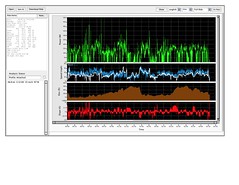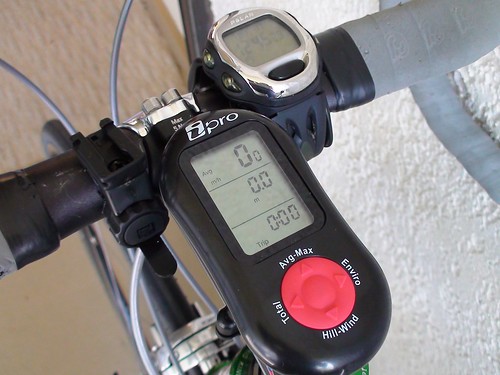I’ve never been a training ride with my bros, when we’ve not stopped for a teammate to mess with their Powertap; to make sure they get the last possible watt measured, set their intervals up, they forgot to set it right, or something. While Powertaps have certainly improved from the days of failing on the bike, they’re still a complicated on-board, super-power-measuring computer. I’m not a Powertap user and have nothing bad to say about their devices – dudes swear by them, I know.
But I’ve avoided Powertaps because I don’t want to over-complicate my riding and train with another computer – I usually just need to ride consistently to get into shape. I spent enough time messing with the first Polar power meter and pulled that off the bike after a season. The Polar was (still is?) poorly engineered. I could sort of understand measuring chain vibrations, but not cords next to pulleys, small connection points, and how it sucked up battery life. SRM isn’t in my consideration for the same reason as Powertap.
iBike is going on 3 years in the market and I’ve seen them on an increasing number of bikes on rides and at races. iBike approaches power meters differently and a big-brained engineer applied Newton’s 3rd law that resistive forces must exactly equal applied forces:
“Power measurement is really about the measurement of force: Power = Force x Speed. Cyclists apply forces to bike pedals in order to overcome the forces resisting forward motion (hill climbs, wind resistance, rolling resistance, acceleration, etc.). Traditional power meters measure the forces applied by the cyclist. The new iBike Pro is the first power meter that measures the resistive forces working against the cyclist.”
I met John Hamann, CEO of iBike, at Interbike and learned that iBike is targeting fitness rides with a new, even easier-to-use model. Simpler power measuring is what I’m interested in and received an iBike Pro III unit just before our Kona trip.
Do the Hokey-Pokey
If you follow power meters, you’ve probably heard about the iBike Hokey Pokey – the setup process of leveling the bike, turning it around, coasting down, and a 4 mile ride. While the obsessive amongst us would do that several times with aero helmet/skin suit and without, I just followed the quick start guide (pdf) and started riding. (Note: vacation rules permit only so much time for these matters, I’ll re-calibrate back home).
The iBike was a quick setup and I’ve been measuring my rides here on Kona (iBke file). I’ve shared the files with Andrew and Joe (coach, teammate) and they think the power numbers are low compared to their Powertaps; possibly, but even if the iBike doesn’t measure like SRM or Powertaps, I can still baseline power and the measurements are definitely good enough (iBike would argue even better).
I’ll take the simplicity over complexity and I’ll let you read all the marketing and determine which unit is best. For the riding and training I’m doing, and the fitness rider, the iBike is a good choice. I’ll keep the iBike a while longer and report back on more rides and how it does in 40 degress and raining.
Cargo Power
The iBike is simple enough to setup, with two sensors and a head unit, that I’m going to put it on Bettie – why not? I’d like to know how much power I’m putting out when delivering the goods. I think other Cargonistas would like to know as well; especially when I turn on the Stokemonkey.
A few issues
iBike has lots of screens, but I can’t see time and my averages on one of them. iBike addresses this with programmable intervals. Considering my workouts change with every ride that’s a hassle. I’d rather just have a watch on the screen.
The setup process, while simplified, still has lots of screens and I get lost frequently on what is a change, accepting it, and how to exit setup. For a while, I was in trainer mode (settings for the wind trainer) and don’t even know how I did that – I’d find myself just pushing the buttons and toggling screens until I got what I wanted.
I also noticed that iBike doesn’t seem to measure when I’m on a descent, with a tailwind, and cranking. I guess that’s in their formula, but I know I’m putting out power, staying on top of the gear, and not sure if iBike is measuring that or not.
Mac Compatible
 Hooray! The iBike Pro is compatible with Macs – install the software, connect the head unit, and you’re looking at power files. The software isn’t Mac native, installs some odd usb drivers, but hey it works and cool. It’s also free.
Hooray! The iBike Pro is compatible with Macs – install the software, connect the head unit, and you’re looking at power files. The software isn’t Mac native, installs some odd usb drivers, but hey it works and cool. It’s also free.
I also use CyclingPeaks software to share files with a coach; both online and on the desktop. Note that Peaksware (makers of the software and website) has an unusally restrictive licensing policy for moving the software to another machine and using it on more than one machine. Where most software allows you to use it on a desktop and laptop, CyclingPeaks does not. I think that’s because of their CD-key DRM scheme. I asked their CEO about this matter and he said:
“We do our best to efficiently support customers who want to move the product from computer to computer during upgrades. The policy is simply a business decision. Our pricing is based on single computer installations with a significant discount for people who want to use it on more than one computer.”
Thanks! Donavon Guyot CEO
That business decisions is contrary to software makers such as Microsoft, Adobe, and every other application I own. If you’re considering power-measuring software and a Mac user, iBike wins.
Power is Relative
When considering power meters, remember that the measurements are relative to you. While it didn’t do well on the road, the Polar Power Unit worked great on the trainer and I also have a Taxc with power and it works well, measuring my workouts and I plan power training with it. This comparison chart shows 4 meters on the same bike. iBike is usually lower and SRM higher, which is why the Pros love SRM.
Training with power has matured and become more mainstream, welcoming more riders than just the pros and yes it can make a difference, that last 10 – 15% in a race, a tour, or dropping your buddies on the weekends.
For more on power, check these resouces.
Related Reviews
More iBike reviews and discussion.
- iBike initial review – Tossing and Tortured ‘Till Dawn
- Sqidoo Bike Power
- Weight Weenies: The iBIke revisited
We're riding townies, adventure, and mountain bikes. Find recommendations on our store page. As Amazon Associates we earn from qualifying purchases.
